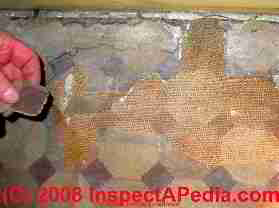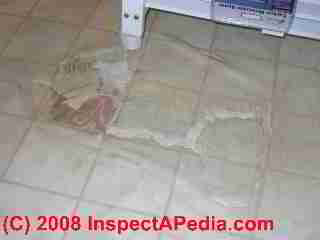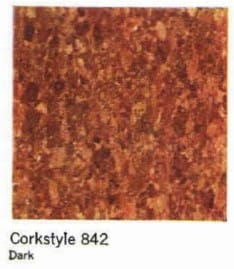 Inspect & Test to Identify Sheet Flooring that May Contain Asbestos
Inspect & Test to Identify Sheet Flooring that May Contain Asbestos
- POST a QUESTION or COMMENT about sheet flooring products that might contain asbestos
Asbestos-containing sheet flooring or resilient flooring product testing & visual inspection for identification of linoleum, asphalt-saturated felt based flooring, vinyl & cork floors.
This article describes simple visual inspection and testing using odorless paint thinner or turpentine to separate true linoleum or cork floors from possible, probable, or known asbestos-containing resilient sheet flooring.
This article also provides links to certified asbestos test labs should testing be needed. Our page top photo, contributed by a reader, contains visual clues indicating that this is a saturated felt backed sheet flooring product that may contain asbestos.
InspectAPedia tolerates no conflicts of interest. We have no relationship with advertisers, products, or services discussed at this website.
- Daniel Friedman, Publisher/Editor/Author - See WHO ARE WE?
How to Research, Inspect & Test Sheet Flooring to Distinguish Asphalt-saturated felts, Linoleum, Vinyl & Cork Materials
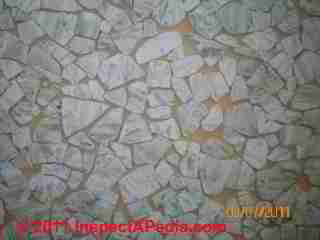
This sheet flooring was identified by a reader in a 1964 home. She found remnants in the bottom of a kitchen cabinet on which was imprinted "Armstrong". Is it linoleum?
[Click to enlarge any image]
A closer look at the product including its backing would be needed. It could be, but this pattern looks more modern to us and is probably a vinyl sheet flooring product.
At ASBESTOS FLOOR TILE IDENTIFICATION PHOTOS 1949-1959 we include a reader report of lab testing performed on this flooring and confirming that it contained "70% asbestos".
Check the building age and probable flooring age
Visual Inspection of Sheet Flooring Backer Material
A laboratory test is necessary, using a certified asbestos test lab, to be certain that a material does not contain asbestos. But some visual and other simple tests can give reliable results.
True linoleum sheet flooring: check the back surface of the sheet flooring to look for a coarse brown fabric (jute) - indicating traditional non-asbestos-containing linoleum. This is a true linoleum product. Take a look at the antique linoleum flooring shown below - this is a burlap or jute backed product. More photo examples and linoleum identification aids are
at LINOLEUM & SHEET FLOORING.
Asphalt-felt-based sheet flooring: check the back surface of the sheet flooring for black paper-like material that resembles roofing felt - indicating older sheet flooring products that may contain asbestos in the backer. In our reader-provided photo just below, the torn sheet flooring shows its asphalt-saturated felt backer even without turning the material over for inspection. It would be prudent to assume that at least the felt backing for this flooring material contains asbestos.

Asphalt-saturated felt (paper) backed flooring, used as early as 1910 in the U.S., looks like but is not linoleum flooring. Armstrong's Linoflor, produced beginning in 1937, is an asphalt-based-backer sheet flooring that some referred to and continue to refer to (in my opinion loosely) as "linoleum", adding to the generic use of that word for sheet flooring. - Wilson & Snodgrass, U.S. FPL (2007)
Vinyl sheet flooring: check the back surface of the sheet flooring for white or light colored backer material. Some of these older sheet flooring products up to the early 1980's may contain asbestos.
This product may also look like linoleum bit is almost certainly a vinyl product. But without knowing the age of this flooring type we cannot be sure if its backer or fillers contain asbestos or not. The floor at below left was tested and shown to be asbestos free.
The flooring backer shown below, from a floor dating before 1980, may contain asbestos.
- Cork flooring: tiles or sheet flooring. Cork flooring is easily recognized by visual inspection as it looks like ... well, cork fragments glued together. Cork flooring does not contain asbestos.
However Armstrong and possibly some other vinyl-asbestos or asphalt asbestos floor tile manufacturers produced those floor tiles in a cork pattern that is similar to true cork. The difference, however, is apparent on close inspection of the floor surface. The cork tile patterns (as opposed to true cork) are a printed-on design rather than glued-together cork fragments.
The flooring at below left is a true cork floor section.
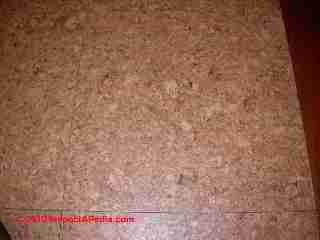
We show a fragment of cork flooring below .
[Click to enlarge any image]
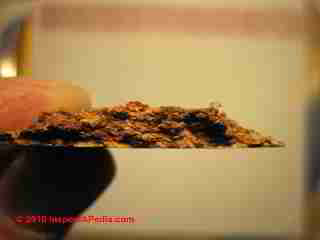
Below we illustrate a 1960's Armstrong vinyl asbestos floor tile in the company's cork pattern. This asphalt and then vinyl asbestos flooring was produced beginning in the 1950's.
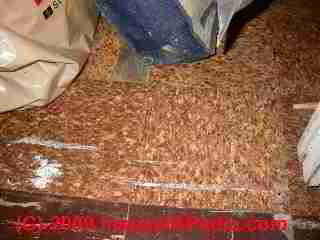
Solvent Tests for Flooring Identification
Wilson & Snodgrass, U.S. FPL (2007) give some helpful suggestions for flooring type identification using a simple solvent. Solvent testing can provide some (but not complete) identifying information about both sheet flooring and resilient tile flooring.
The authors recommend using turpentine, but for a less smelly mess I'd also add the use of odorless paint thinner as your test solvent. Wilson & Snodgrass explain that
If a clean, white cloth moistened with a solvent such as turpentine does not take up the color of the flooring when it is rubbed in a small, inconspicuous, unwaxed area, the flooring is vinyl.
The color will transfer to the cloth if the flooring is asphalt or rubber. A search of historic records or laboratory testing may be needed to distinguish between asphalt and rubber flooring. - Wilson & Snodgrass, U.S. FPL (2007)
Watch out: if the flooring is not clean you may be confused by dirt or old wax coatings transferring to your test cloth.
Watch out: when choosing a solvent, in just about any cleaning or investigation procedure it's best to start with the most mild and safe ingredients possible. I would not use lacquer thinner which is likely to damage the floor surface. Other solvents such as hexane are used in our forensic lab for a reliable confirmation of rubber and some other materials, but this solvent is dangerous to handle and may be carcinogenic as well.
Even alcohol (iso propanol) that is readily available can create a mess if you try it on an alcohol-soluble painted surface. Stick to odorless paint thinner.
Certified Asbestos Testing Laboratory Tests for Asbestos in Flooring
If you are facing significant building renovation, remodeling or cleanup costs that include disturbing asbestos-suspect flooring, ceiling paints, insulation, or other hazardous materials, it makes sense to ask for a hazard confirmation by a certified asbestos testing laboratory.
Suspected or Presumed Asbestos Containing Material Floor Sample Preparation
Typically an asbestos test lab needs only a small representative sample of flooring material to test for asbestos - about a square inch of intact material. If the existing floor has a damaged or loose section it may be possible to simply pick up a fragment, bag it in a clean Ziplok™ type freezer bag and label it for mailing to the laboratory.
For larger segments it may be possible to clean-cut a sample using a utility knife, with wetting if needed to avoid creating a possible asbestos dust hazard. [McCrone (1987) describes laboratory procedures that require breaking the sheet or tile flooring sample to leave fibers exposed for direct examination.]
Best advice: ask your certified asbestos test laboratory what sample collection, packaging and handling procedures they require.
ASBESTOS TESTING LAB LIST provides contact information for sources of currently-certified asbestos testing laboratories.
Please do not mail flooring samples nor anything else to us at InspectApedia unless we have agreed by prior discussion. Please do not mail whole sheets, boxes of multiple tiles etc. The test laboratory does not need so much material and does not want to have to dispose of it.
Identify Sheet Flooring & Resilient Floor Manufacturers, Brands & Styles
- Armstrong flooring in the company's wide range of floor tiles is discussed & identified in detail at ARMSTRONG FLOOR TILES - 1950's.
Armstrong's sheet flooring is described at ARMSTRONG SHEET FLOORING
Armstrong, Congoleum, Linoleum sheet flooring is also discussed at LINOLEUM & SHEET FLOORING
Also see FLOORING MATERIALS, Age, Types. - Congoleum Nairn flooring: please see CONGOLEUM-NAIRN FLOORING;
also see CONGOLEUM FLOORING HISTORY and FLOOR TYPES & DEFECTS. - For identification guides to all older flooring brands of asphalt asbestos, vinyl asbestos, and similar flooring products see FLOOR TILE / SHEET FLOORING PHOTO GUIDES - list of photo guides
- To identify unknown flooring tile products: at ASBESTOS FLOOR TILE PHOTO ID REQUESTS we include additional photographs of both tile and sheet flooring products submitted by readers with requests for more information.
- To identify unkown sheet flooring products, see RESILIENT SHEET FLOORING ID GUIDE
...
Continue reading at LINOLEUM & SHEET FLOORING or select a topic from the closely-related articles below, or see the complete ARTICLE INDEX.
Or see ASBESTOS FLOOR TILE IDENTIFICATION FAQs
Or see this
Article Series on Resilient & Sheet Flooring with & without asbestos
- ASBESTOS FLOOR IDENTIFICATION
- ASBESTOS TESTING LAB LIST for a list of certified asbestos testing laboratories
- DOES THIS FLOOR CONTAIN ASBESTOS? - 5 easy questions to tell if your FLOOR probably contains asbestos -
- DOES THIS MATERIAL CONTAIN ASBESTOS? - 5 easy questions to tell if a BUILDING MATERIAL probably contains asbestos -
- FLOOR, RESILIENT VINYL or CORK - best installation practices for modern sheet or resilient flooring
- RESILIENT SHEET FLOORING ID GUIDE - home - home
- ARMSTRONG BRADFORD BRICK SHEET
- ARMSTRONG CRAFTLON & SOLARIAN FLOORING
- ARMSTRONG RUBBER BACKED RUG PATTERNS
- ARMSTRONG SHEET FLOORING 1940 - 1980
- CONGOLEUM NAIRN SHEET FLOORING 1960 - 1980
- FINLAND VINYL SHEET FLOORING POSSIBLE ASBESTOS
- LINOLEUM & OTHER SHEET FLOORING
- MARBLE / STONE CHIP PATTERN FLOORING ASBESTOS
- POURED-IN-PLACE FLOORING, RESILIENT
- RESILIENT VINYL or CORK FLOOR, MODERN
- SHEET & TILE FLOORING ASBESTOS ID-BRICK PATTERN ID
- SHEET & TILE FLOORING ASBESTOS ID-WHITE BRICK
- SWEDISH TARKETT FLOORING POSSIBLE ASBESTOS
- VINYL-ASBESTOS SHEET FLOORING
- SHEET FLOORING POSSIBLE ASBESTOS - 1920-1988
- SHEET FLOORING INSPECT / TEST
- SHEET FLOORING NON-ASBESTOS EXAMPLES
- SHEET FLOORING TYPE IDENTIFICATION
Suggested citation for this web page
SHEET FLOORING INSPECT / TEST at InspectApedia.com - online encyclopedia of building & environmental inspection, testing, diagnosis, repair, & problem prevention advice.
Or see this
INDEX to RELATED ARTICLES: ARTICLE INDEX to ASBESTOS HAZARDS
Or use the SEARCH BOX found below to Ask a Question or Search InspectApedia
Ask a Question or Search InspectApedia
Try the search box just below, or if you prefer, post a question or comment in the Comments box below and we will respond promptly.
Search the InspectApedia website
Note: appearance of your Comment below may be delayed: if your comment contains an image, photograph, web link, or text that looks to the software as if it might be a web link, your posting will appear after it has been approved by a moderator. Apologies for the delay.
Only one image can be added per comment but you can post as many comments, and therefore images, as you like.
You will not receive a notification when a response to your question has been posted.
Please bookmark this page to make it easy for you to check back for our response.
IF above you see "Comment Form is loading comments..." then COMMENT BOX - countable.ca / bawkbox.com IS NOT WORKING.
In any case you are welcome to send an email directly to us at InspectApedia.com at editor@inspectApedia.com
We'll reply to you directly. Please help us help you by noting, in your email, the URL of the InspectApedia page where you wanted to comment.
Citations & References
In addition to any citations in the article above, a full list is available on request.
- Asbestos Identification, Walter C.McCrone, McCrone Research Institute, Chicago, IL.1987 ISBN 0-904962-11-3. Dr. McCrone literally "wrote the book" on asbestos identification procedures which formed the basis for current work by asbestos identification laboratories.
- Richa Wilson, Kathleen Snodgrass, " EARLY 20TH-CENTURY BUILDING MATERIALS: RESILIENT FLOORING " [Very large PDF], Richa Wilson, Intermountain Regional Architectural Historian Kathleen Snodgrass, Project Leader, United States Department of Agriculture Forest Service, Technology & Development Program, August 2007, 7300-0773-2322-MTDC. Contact Kathie Snodgrass at MTDC: Tel: 406–329–3922, Email: ksnodgrass@fs.fed.us or Richa Wilson, author; USDA Forest Service, Intermountain Region, 324 25th Street, Ogden, UT 84401. Phone: 801–625–5704; fax: 801–625–5229: e-mail: rwilson@fs.fed.us
- Resilient Floor Covering Institute, 401 East Jefferson Street, Suite 102, Rockville, MD 20850, Tel: 301–340–8580, Website: http://www.rfci.com
- In addition to citations & references found in this article, see the research citations given at the end of the related articles found at our suggested
CONTINUE READING or RECOMMENDED ARTICLES.
- Carson, Dunlop & Associates Ltd., 120 Carlton Street Suite 407, Toronto ON M5A 4K2. Tel: (416) 964-9415 1-800-268-7070 Email: info@carsondunlop.com. Alan Carson is a past president of ASHI, the American Society of Home Inspectors.
Thanks to Alan Carson and Bob Dunlop, for permission for InspectAPedia to use text excerpts from The HOME REFERENCE BOOK - the Encyclopedia of Homes and to use illustrations from The ILLUSTRATED HOME .
Carson Dunlop Associates provides extensive home inspection education and report writing material. In gratitude we provide links to tsome Carson Dunlop Associates products and services.


